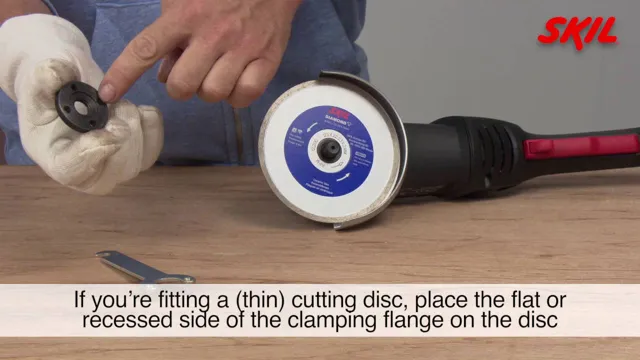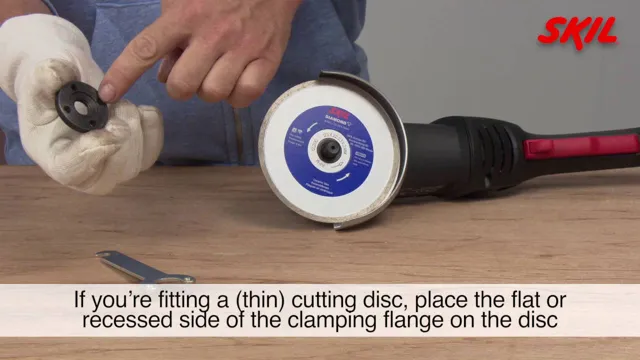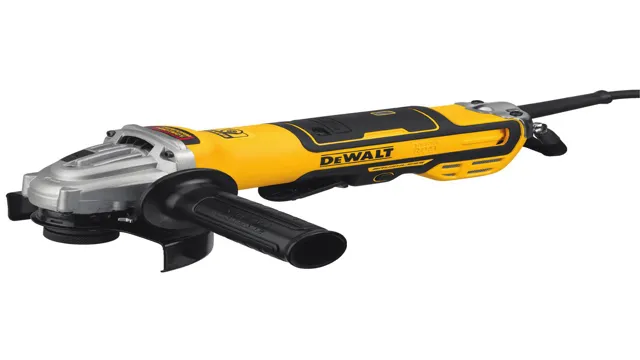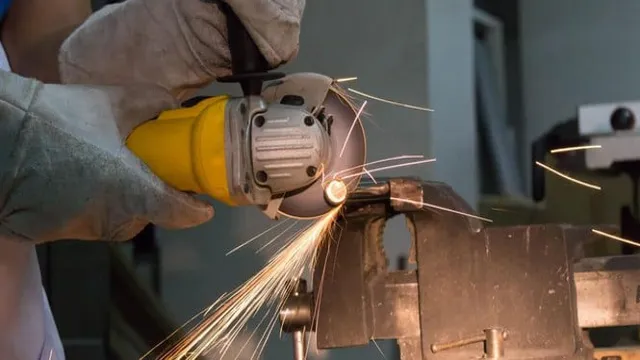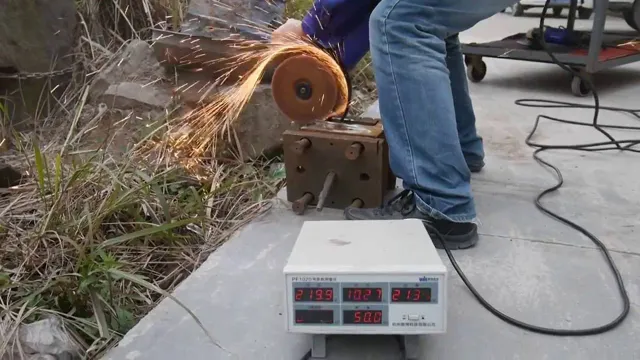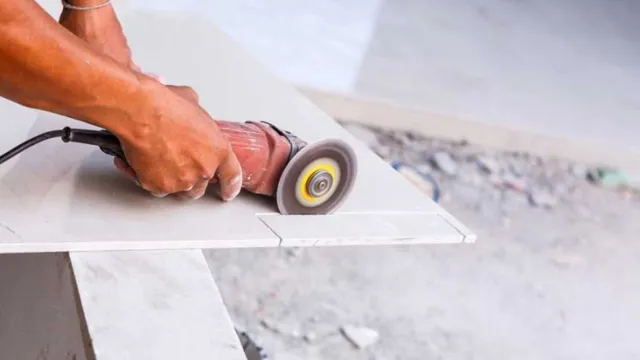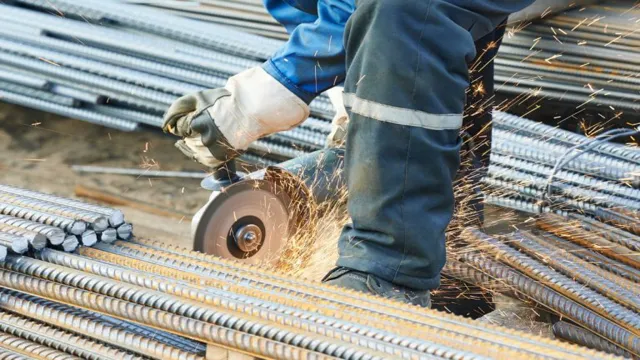What Angle Grinder Disc for Metal? Find the Perfect Option for Your Project
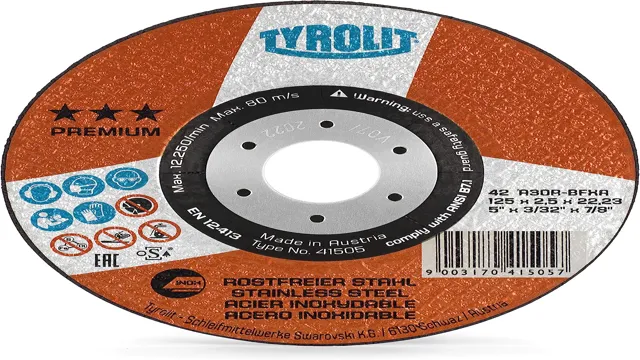
Are you looking for the best angle grinder discs for metal? Look no further! As a metalworker, you know that getting the right tool can make a world of difference in the quality and effectiveness of your work. An angle grinder is no exception, and having the right discs to go with it can take your metal grinding and cutting to the next level. In this blog, we’ll explore the top angle grinder discs available for metal work, and break down what makes them stand out from the competition.
So sit back, grab a cup of coffee, and let’s dive in!
Introduction
If you’re looking to tackle a metal project with your angle grinder, it’s important to choose the right disc for the job. For cutting through metal, you’ll want to use a diamond blade or a metal cut-off disc. The diamond blade is ideal for harder metals like steel, while the metal cut-off disc is best suited for softer metals like aluminum or copper.
These discs are tough and durable, with high-speed cutting ability to get the job done quickly and efficiently. When it comes to smoothing out rough edges or removing rust from metal, a flap disc or a sanding disc is your best bet. The flap disc is great for heavy-duty grinding, while the sanding disc is perfect for lighter jobs.
No matter which disc you choose, make sure it’s compatible with your angle grinder and that you follow all safety precautions when using it. With the right disc and a little know-how, you can tackle any metal project with ease.
What is an Angle Grinder?
An angle grinder is a versatile power tool that can be used for cutting, grinding, and polishing various materials. It is commonly used in construction, metalworking, and woodworking industries, and can even be used for DIY projects at home. The tool features a motor that spins a disc or wheel attached to the arbour, which can be changed depending on the task at hand.
Angle grinders come in different sizes and power levels, with the most common being the 5-inch grinder which is ideal for most applications. The tool can be dangerous if not used correctly, so it is important to wear protective gear such as gloves and eye and ear protection.
As versatile as it is, an angle grinder is a valuable investment for anyone who works with metal, concrete, or wood.
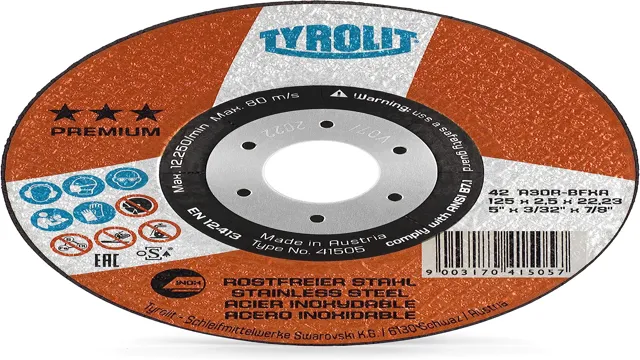
Why use an Angle Grinder for Metal?
When it comes to working with metal, there are a multitude of tools and techniques available. However, one tool that stands out as a reliable choice is the angle grinder. Angle grinders are handheld power tools that feature a spinning disc or wheel, allowing for fast and efficient grinding, cutting, and polishing of metal surfaces.
Using an angle grinder for metal has many advantages, including its ability to quickly remove rust, smooth rough edges, cut through thick metal sheets and pipes, and sharpen blades. Its versatility makes it a valuable tool in any metalworking shop or DIY project. With the right attachments, an angle grinder can also be used for removing paint, sanding, and even for cutting through concrete and masonry.
Overall, an angle grinder is an essential tool for anyone working with metal, offering speed, efficiency, and precision for a wide range of tasks.
Importance of the Right Disc
When it comes to using power tools like angle grinders, choosing the right disc can make all the difference. A high-quality disc that is compatible with your tool and suited for the task at hand will not only produce better results but also make the job easier and safer. On the other hand, a wrong disc can result in poor performance, damaged equipment, and even injury.
That’s why it’s essential to understand the importance of the right disc and how to select one that meets your needs. By considering factors such as the material you’re working with, the level of abrasiveness required, and the size and speed of your tool, you can find the perfect match and achieve optimal results. So don’t overlook the significance of the right disc and take the time to choose wisely.
Types of Angle Grinder Discs for Metal
When it comes to working with metal using an angle grinder, it’s important to have the right type of disc for the job. There are various types of angle grinder discs for metal that you can choose from, each with its unique properties. Firstly, you have the abrasive discs, which are ideal for grinding and removing surface materials.
You can choose from either diamond-tipped discs or those made from aluminum oxide. The latter is ideal for grinding down metal surfaces that are slightly uneven. Additionally, flap discs are another option that you can use for grinding and finishing metals.
They typically have a non-woven nylon design and are perfect for removing minor imperfections. Lastly, cutting discs are the best option for cutting through metal. You can choose from a variety of materials, including diamond-tipped or those made from silicon carbide, which are perfect for cutting through harder metals.
Overall, choosing the right angle grinder disc for metal depends on the type of metal you’re working with and the desired outcome.
Cut-Off Discs
When it comes to metalworking with an angle grinder, one of the most essential tools you will need is the cut-off disc. These circular abrasive discs are specifically designed for cutting through tough materials like metal. There are several types of cut-off discs available in the market, each designed for specific applications.
The most common types of cut-off discs for metal are aluminum oxide discs, diamond discs, and abrasive blades. Aluminum oxide discs are the most widely used because they are affordable and ideal for cutting through soft metals. Diamond discs, on the other hand, are perfect for cutting through hard metals like steel and titanium.
Abrasive blades are the most heavy-duty option and ideal for grinding and cutting through thick metal sheets. Whichever type of cut-off disc you choose, make sure to consider its grit size and thickness to ensure that it is appropriate for your specific metalworking needs.
Flap Discs
When it comes to working with metal, an angle grinder is a versatile tool that can make quick work of tough jobs. However, choosing the right type of disc for the job is essential. Flap discs are a popular choice for grinding and finishing metal surfaces.
These discs are made up of overlapping layers of abrasive cloth that are coated with resin. They are designed to last longer than traditional grinding wheels and provide a smoother finish. Flap discs are available in various grits, allowing you to choose the right one for your specific task.
Whether you’re grinding, smoothing, or blending metal surfaces, flap discs are an excellent choice for getting the job done quickly and efficiently. So, if you’re in the market for new grinding discs for your angle grinder, why not give flap discs a try? They’re a versatile option that’s sure to make your work easier, faster, and more efficient.
Grinding Discs
Angle grinder discs are an essential tool for any DIY enthusiast or professional welder, and it’s important to know which type to use for each task. When it comes to metal, there are a few different types of discs to choose from. The first is the cutting disc, which is designed to cut through metal quickly and efficiently.
Next up is the grinding disc, which can be used to remove rust, smooth out welds, and prepare metal surfaces for further work. Another option is the flap disc, which can be used for both grinding and finishing tasks, and is known for its ability to produce a smooth, even finish. Each type of disc has its own unique properties and is best used for certain tasks, so be sure to choose the right one for your project needs.
Factors to consider when choosing an Angle Grinder Disc for Metal
When it comes to selecting the right angle grinder disc for metal, there are several factors to consider. Firstly, you should choose a disc that matches the size of your grinder, ensuring it fits perfectly. The material of the disc is also important, as the hardness of the metal you’re cutting will determine what type of abrasive you’ll require.
For instance, steel and iron will require a harder disc compared to aluminum and non-ferrous metals. You should also select a disc with the appropriate thickness, as this can affect the speed and accuracy of your cuts. Additionally, pay attention to the disc’s grit level, as this determines how smooth or rough your cuts will be.
Lastly, consider the type of cut you’re making and whether a cutting or grinding disc is more suitable for the job. By considering these factors, you’ll be better equipped to choose the right angle grinder disc for metal that suits your needs.
Disc size
When it comes to choosing an angle grinder disc for metal, disc size is an important factor to consider. The size of the disc you choose can affect the performance of your angle grinder. The smaller the disc diameter, the more control you have while working with the grinder.
However, a smaller disc may take longer to complete a job. A larger disc, on the other hand, can get the job done faster, but it also requires more skill to maneuver. Generally, angle grinder discs come in sizes ranging from
5 inches to 9 inches. Consider your skill level and the size of the project when choosing a disc size. Keep in mind that smaller discs are ideal for precision work, while larger discs are better suited for heavier tasks.
Ultimately, the right disc size for your angle grinder depends on the specific job at hand.
Disc thickness
When choosing an angle grinder disc for metal, disc thickness is a crucial factor to consider. Thicker discs are more durable and can handle higher-pressure applications without wearing down quickly. However, they may also be heavier and slower, making them less suitable for certain tasks.
Thinner discs, on the other hand, are lighter and faster, allowing for more precise cuts and easier maneuverability. However, they are generally less durable and can wear down faster when used for heavier applications. It’s important to consider the specific task at hand and choose a disc thickness that is appropriate for the job.
Ultimately, finding the right balance between durability and speed is key to choosing the best angle grinder disc for metal.
Speed
Speed Choosing the right angle grinder disc for metal can make a huge difference in the speed and effectiveness of your work. Factors to consider include the size of the disc, the type of abrasive material, and the speed of the grinder. A smaller disc will allow for greater precision, while a larger disc will provide faster cutting capabilities.
When it comes to abrasive material, there are many options to choose from, including aluminum oxide and zirconia alumina. The hardness of the metal being worked on will also impact the ideal abrasive material for the task at hand. Finally, it’s important to match the speed of the grinder to the disc being used, as a disc that is too fast or too slow can affect the longevity and effectiveness of the disc, causing it to wear down or break prematurely.
By taking these factors into consideration, you can choose the best angle grinder disc for your metalworking needs and achieve optimal speed and precision.
Material being worked on
Angle Grinder Disc, Metal When it comes to metalwork, choosing the right angle grinder disc is crucial for achieving the desired results. There are several factors to consider when deciding which disc to use, such as the type of metal being worked on, the thickness of the material, and the specific task at hand. For example, a cutting disc is ideal for removing excess metal or cutting through thick sheets, while a grinding disc is best for smoothing out rough edges and welding seams.
Additionally, the size of the disc and the angle grinder itself should be taken into account, as larger discs may not fit on smaller grinders. It’s important to also consider the disc’s material, as some are better suited for specific metals. For instance, a ceramic disc may be better for working on hard metals like stainless steel, while a diamond disc is ideal for cutting through concrete or stone.
By taking these factors into account, one can choose the most appropriate angle grinder disc for their specific metalworking needs.
Conclusion
In conclusion, when it comes to choosing the right angle grinder disc for metal, it’s all about finding that sweet spot between toughness and finesse. You want a disc that can handle the heat of metalworking without losing its shape or abrasive qualities, but one that can also provide precision cutting and grinding when needed. Just remember, a dull or inappropriate disc can turn your metalworking project into a real nightmare – so choose wisely and grind on with confidence!”
Summary of the best discs for metal
When it comes to choosing the best angle grinder disc for metal, there are a few factors to consider. Firstly, you’ll want to think about the type of metal you’ll be working with. Stainless steel, for example, requires a different disc than mild steel.
Secondly, consider the thickness of the metal you’ll be cutting or grinding. Thicker metal will require a disc with a higher grit level, as well as a more durable material. In terms of the metalworking process itself, you’ll want to consider the speed and power of your angle grinder.
Depending on the disc you choose, you may need a more powerful motor to handle the demands of metalworking. Finally, safety is always a concern, so be sure to invest in a high-quality disc with a reinforced center and a clearly marked maximum RPM rating. By taking all of these factors into account, you’ll be able to choose the best angle grinder disc for metal that meets your specific needs and keeps you safe on the job.
Final thoughts and recommendations
When choosing an angle grinder disc for metal, there are several factors to consider that can significantly impact the outcome of your project. Firstly, it’s essential to determine the type of metal you’ll be working with and the abrasive material that would be best suited for it. For example, if you’re working with stainless steel, a ceramic abrasive disc may be more effective than an aluminum oxide one.
Additionally, you’ll need to consider the disc’s grit and size, as these will affect the disc’s aggressiveness and the final finish on your project’s surface. Safety is another crucial factor, so you should choose a disc that is rated for the maximum RPM for your angle grinder and wear appropriate personal protective equipment. Finally, consider the overall cost and potential lifespan of the disc, as well as user reviews and recommendations.
By taking all these factors into consideration, you can select an angle grinder disc for metal that will best suit your needs and ensure a successful project. Keywords: angle grinder disc, metal, abrasive material, grit, size, safety, cost, lifespan, user reviews, recommendations.
FAQs
What type of angle grinder disc is best for cutting metal?
A diamond blade or a cut-off wheel made of abrasives are the best options for cutting metal with an angle grinder.
Can you use a grinding disc to cut metal with an angle grinder?
It is not recommended to use a grinding disc to cut metal with an angle grinder, as they are not designed for this purpose.
How thick should the angle grinder disc be for cutting metal?
The thickness of the disc should match the thickness of the material being cut. For most metal cutting applications, a thickness of 1.6mm to 2mm is recommended.
What is the difference between a cutting disc and a grinding disc for an angle grinder?
A cutting disc is thinner and is used for cutting, while a grinding disc is thicker and is used for grinding and smoothing surfaces.
Can an angle grinder disc be used to cut other materials besides metal?
Yes, angle grinder discs can be used to cut materials such as concrete, stone, and tile, depending on the type of disc being used.
How do you know when it is time to replace the angle grinder disc?
Signs that it is time to replace the disc include wear and tear, chips or cracks in the disc, and decreased cutting or grinding performance.
What safety precautions should be taken when using an angle grinder disc for cutting metal?
Safety precautions include wearing protective gear such as goggles, gloves, and a mask, securing the material being cut, and ensuring the disc is securely fastened to the angle grinder.

